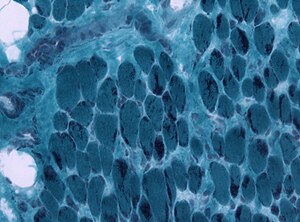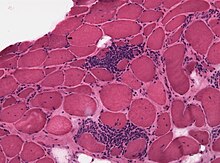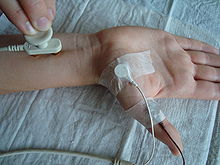J u m p t o c o n t e n t
M a i n m e n u
M a i n m e n u
N a v i g a t i o n
● M a i n p a g e ● C o n t e n t s ● C u r r e n t e v e n t s ● R a n d o m a r t i c l e ● A b o u t W i k i p e d i a ● C o n t a c t u s ● D o n a t e
C o n t r i b u t e
● H e l p ● L e a r n t o e d i t ● C o m m u n i t y p o r t a l ● R e c e n t c h a n g e s ● U p l o a d f i l e
S e a r c h
Search
A p p e a r a n c e
● C r e a t e a c c o u n t ● L o g i n
P e r s o n a l t o o l s
● C r e a t e a c c o u n t ● L o g i n
P a g e s f o r l o g g e d o u t e d i t o r s l e a r n m o r e ● C o n t r i b u t i o n s ● T a l k
( T o p )
1 S i g n s a n d s y m p t o m s
2 C a u s e s
3 D i a g n o s i s
4 P r o g n o s i s
5 S e e a l s o
6 N o t e s
7 R e f e r e n c e s
8 F u r t h e r r e a d i n g
9 E x t e r n a l l i n k s
T o g g l e t h e t a b l e o f c o n t e n t s
N e u r o m u s c u l a r d i s e a s e
1 1 l a n g u a g e s
● ا ل ع ر ب ي ة ● C a t a l à ● D e u t s c h ● F r a n ç a i s ● 한 국 어 ● I t a l i a n o ● N e d e r l a n d s ● P o r t u g u ê s ● S i m p l e E n g l i s h ● С р п с к и / s r p s k i ● S v e n s k a
E d i t l i n k s
● A r t i c l e ● T a l k
E n g l i s h
● R e a d ● E d i t ● V i e w h i s t o r y
T o o l s
T o o l s
A c t i o n s
● R e a d ● E d i t ● V i e w h i s t o r y
G e n e r a l
● W h a t l i n k s h e r e ● R e l a t e d c h a n g e s ● U p l o a d f i l e ● S p e c i a l p a g e s ● P e r m a n e n t l i n k ● P a g e i n f o r m a t i o n ● C i t e t h i s p a g e ● G e t s h o r t e n e d U R L ● D o w n l o a d Q R c o d e ● W i k i d a t a i t e m
P r i n t / e x p o r t
● D o w n l o a d a s P D F ● P r i n t a b l e v e r s i o n
I n o t h e r p r o j e c t s
● W i k i m e d i a C o m m o n s
A p p e a r a n c e
F r o m W i k i p e d i a , t h e f r e e e n c y c l o p e d i a
( R e d i r e c t e d f r o m N e u r o m u s c u l a r d i s e a s e s )
A neuromuscular disease is any disease affecting the peripheral nervous system (PNS),[a] neuromuscular junctions , or skeletal muscles , all of which are components of the motor unit .[4] muscle atrophy and weakness. Issues with sensation can also occur.
Neuromuscular diseases can be acquired or genetic . Mutations of more than 650 genes have shown to be causes of neuromuscular diseases.[5] [6] [7] degeneration , autoimmunity , toxins , medications , malnutrition , metabolic derangements , hormone imbalances , infection , nerve compression/entrapment , comprised blood supply , and trauma .[8]
Signs and symptoms [ edit ]
Symptoms of neuromuscular disease may include numbness , paresthesia , muscle atrophy , a pseudoathletic appearance , exercise intolerance , myalgia (muscle pain), fasciculations (muscle twitches), myotonia (delayed muscle relaxation), hypotonia (lack of resistance to passive movement), fixed muscle weakness (a static symptom ), or premature muscle fatigue (a dynamic symptom ).[2] [9] [10] [11]
Neuromuscular disease can be caused by autoimmune disorders,[1] [2] Ehlers–Danlos syndrome ,[12] heavy metal poisoning .[3] myelin , is seen in certain deficiency diseases, such as the failure of the body's system for absorbing vitamin B-12 .[3]
Diseases of the motor end plate include myasthenia gravis , a form of muscle weakness due to antibodies against acetylcholine receptor,[13] [14] Lambert–Eaton myasthenic syndrome (LEMS).[15] Tetanus and botulism are bacterial infections in which bacterial toxins cause increased or decreased muscle tone, respectively.[16] Muscular dystrophies , including Duchenne's and Becker's , are a large group of diseases, many of them hereditary or resulting from genetic mutations , where the muscle integrity is disrupted, they lead to progressive loss of strength and decreased life span.[17]
Further causes of neuromuscular diseases are:
Polymyositis
Inflammatory muscle disorders
Tumors
Diagnosis [ edit ]
Nerve conduction velocity (study)
Diagnostic procedures that may reveal muscular disorders include direct clinical observations. This usually starts with the observation of bulk, possible atrophy or loss of muscle tone. Neuromuscular disease can also be diagnosed by various blood tests and using electrodiagnostic medicine tests[23] electromyography [24] nerve conduction studies .[25] Genetic testing is an important part of diagnosing inherited neuromuscular conditions.[23]
Prognosis [ edit ]
Prognosis and management vary by disease.[citation needed
See also [ edit ]
References [ edit ]
^ a b c Swash, Michael; Schwartz, Martin S. (2013-03-14). Neuromuscular Diseases: A Practical Approach to Diagnosis and Management ISBN 9781447138341
^ Katirji, Bashar (2014). "Clinical Assessment in Neuromuscular Disorders". In Katirji, Bashar; Kaminski, Henry J.; Ruff, Robert L. (eds.). Neuromuscular disorders in clinical practice (Second ed.). New York. ISBN 978-1-4614-6567-6 {{cite book }}: CS1 maint: location missing publisher (link )
^ "GeneTable of Neuromuscular Disorders" .
^ Dowling, JJ; Weihl, CC; Spencer, MJ (November 2021). "Molecular and cellular basis of genetically inherited skeletal muscle disorders" . Nature Reviews. Molecular Cell Biology . 22 11 ): 713–732. doi :10.1038/s41580-021-00389-z . PMC 9686310 PMID 34257452 . S2CID 235822532 .
^ Cohen, Enzo; Bonne, Gisèle; Rivier, François; Hamroun, Dalil (December 2021). "The 2022 version of the gene table of neuromuscular disorders (nuclear genome)" . Neuromuscular Disorders . 31 12 ): 1313–1357. doi :10.1016/j.nmd.2021.11.004 .
^ Katirji, Bashar; Kaminski, Henry J.; Ruff, Robert L., eds. (2014). Neuromuscular disorders in clinical practice (Second ed.). New York. ISBN 978-1-4614-6567-6 {{cite book }}: CS1 maint: location missing publisher (link )
^ "Myopathy Information Page: National Institute of Neurological Disorders and Stroke (NINDS)" . www.ninds.nih.gov . Archived from the original on 2016-04-27. Retrieved 2016-04-24 .
^ Walters, Jon (October 2017). "Muscle hypertrophy and pseudohypertrophy" . Practical Neurology . 17 5 ): 369–379. doi :10.1136/practneurol-2017-001695 ISSN 1474-7766 . PMID 28778933 .
^ Nadaj-Pakleza, Aleksandra (July 2022). "Muscle hypertrophy: indicative of good health or disease? / Hypertrophie musculaire : signe de bonne santé ou de maladie ?" . Les Cahiers de Myologie (in English and French) (25 ): 10–15. doi :10.1051/myolog/202225004 ISSN 2108-2219 .
^ Voermans, Nicol C; Van Alfen, Nens; Pillen, Sigrid; Lammens, Martin; Schalkwijk, Joost; Zwarts, Machiel J; Van Rooij, Iris A; Hamel, Ben C. J; Van Engelen, Baziel G (2009). "Neuromuscular involvement in various types of Ehlers-Danlos syndrome". Annals of Neurology . 65 6 ): 687–97. doi :10.1002/ana.21643 . PMID 19557868 . S2CID 22600065 .
^ Myasthenia Gravis at eMedicine
^ Hill, M (2003). "The Neuromuscular Junction Disorders" . Journal of Neurology, Neurosurgery & Psychiatry . 74 doi :10.1136/jnnp.74.suppl_2.ii32 . PMC 1765619 PMID 12754327 .
^ Lambert-Eaton Myasthenic Syndrome (LEMS) at eMedicine
^ Kumar, Vinay; Abbas, Abul K.; Aster, Jon C. (2014-09-05). Robbins & Cotran Pathologic Basis of Disease ISBN 9780323296359
^ "Muscular Dystrophy Information Page: National Institute of Neurological Disorders and Stroke (NINDS)" . www.ninds.nih.gov . Retrieved 2016-04-24 .
^ Liaison, Janet Austin, Office of Communications and Public. "Polymyalgia Rheumatica and Giant Cell Arteritis" . www.niams.nih.gov . Archived from the original on 2016-05-25. Retrieved 2016-04-24 . {{cite web }}: CS1 maint: multiple names: authors list (link )
^ Polymyositis at eMedicine
^ MedlinePlus Encyclopedia Rhabdomyolysis
^ Leiomyoma at eMedicine
^ Rhabdomyomas at eMedicine
^ a b McDonald, Craig M (2012). "Clinical Approach to the Diagnostic Evaluation of Hereditary and Acquired Neuromuscular Diseases" . Physical Medicine and Rehabilitation Clinics of North America . 23 3 ): 495–563. doi :10.1016/j.pmr.2012.06.011 . PMC 3482409 PMID 22938875 .
^ Darras, Basil T.; Jones, H. Royden Jr.; Ryan, Monique M. ; de Vivo, Darryl C. (2014-12-03). Neuromuscular Disorders of Infancy, Childhood, and Adolescence: A Clinician's Approach ISBN 978-0124171275
^ Electromyography and Nerve Conduction Studies at eMedicine
Further reading [ edit ]
External links [ edit ]
R e t r i e v e d f r o m " https://en.wikipedia.org/w/index.php?title=Neuromuscular_disease&oldid=1204945404 " C a t e g o r y : ● M y o n e u r a l j u n c t i o n a n d n e u r o m u s c u l a r d i s e a s e s H i d d e n c a t e g o r i e s : ● C S 1 m a i n t : l o c a t i o n m i s s i n g p u b l i s h e r ● C S 1 F r e n c h - l a n g u a g e s o u r c e s ( fr ) ● C S 1 m a i n t : m u l t i p l e n a m e s : a u t h o r s l i s t ● A r t i c l e s w i t h s h o r t d e s c r i p t i o n ● S h o r t d e s c r i p t i o n i s d i f f e r e n t f r o m W i k i d a t a ● A l l a r t i c l e s w i t h u n s o u r c e d s t a t e m e n t s ● A r t i c l e s w i t h u n s o u r c e d s t a t e m e n t s f r o m J u n e 2 0 2 2 ● A r t i c l e s w i t h L N B i d e n t i f i e r s ● A r t i c l e s w i t h N K C i d e n t i f i e r s
● T h i s p a g e w a s l a s t e d i t e d o n 8 F e b r u a r y 2 0 2 4 , a t 1 2 : 4 6 ( U T C ) . ● T e x t i s a v a i l a b l e u n d e r t h e C r e a t i v e C o m m o n s A t t r i b u t i o n - S h a r e A l i k e L i c e n s e 4 . 0 ;
a d d i t i o n a l t e r m s m a y a p p l y . B y u s i n g t h i s s i t e , y o u a g r e e t o t h e T e r m s o f U s e a n d P r i v a c y P o l i c y . W i k i p e d i a ® i s a r e g i s t e r e d t r a d e m a r k o f t h e W i k i m e d i a F o u n d a t i o n , I n c . , a n o n - p r o f i t o r g a n i z a t i o n . ● P r i v a c y p o l i c y ● A b o u t W i k i p e d i a ● D i s c l a i m e r s ● C o n t a c t W i k i p e d i a ● C o d e o f C o n d u c t ● D e v e l o p e r s ● S t a t i s t i c s ● C o o k i e s t a t e m e n t ● M o b i l e v i e w




